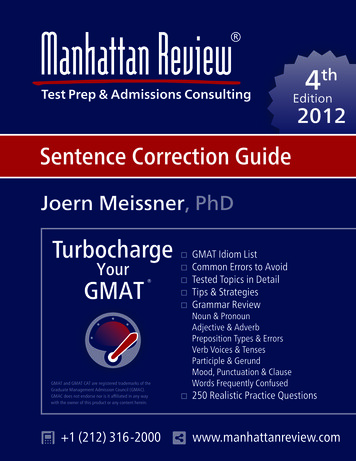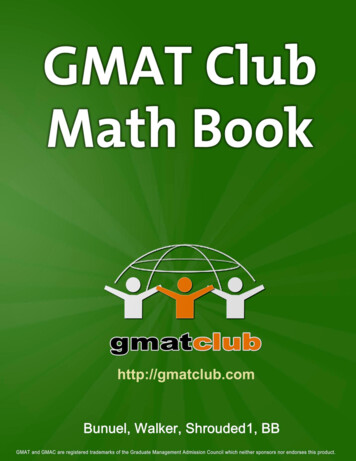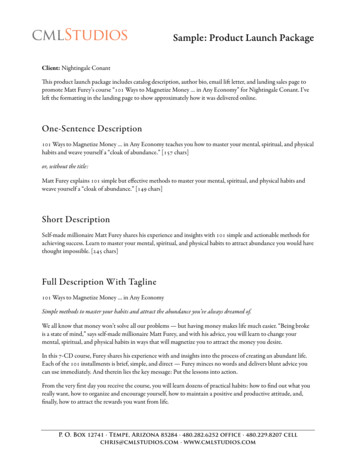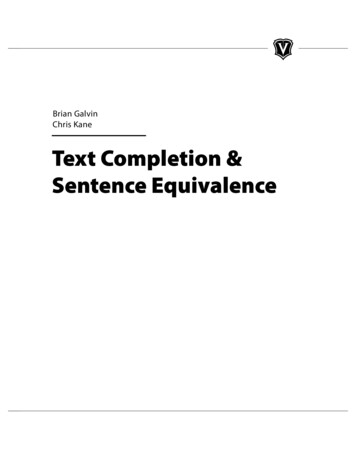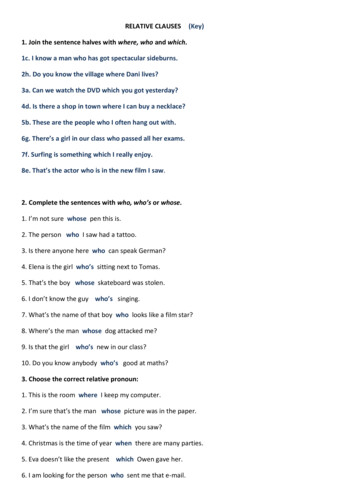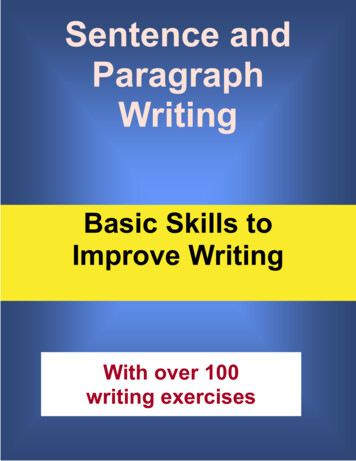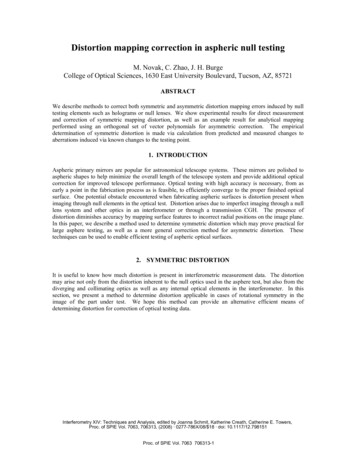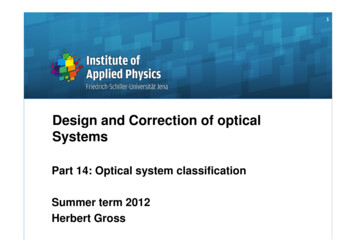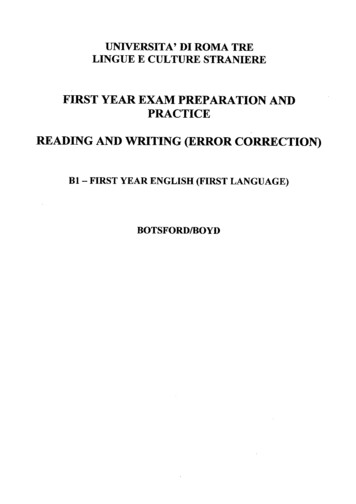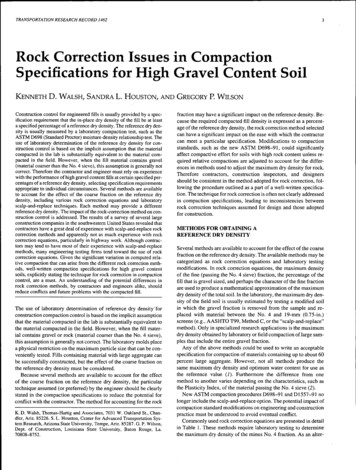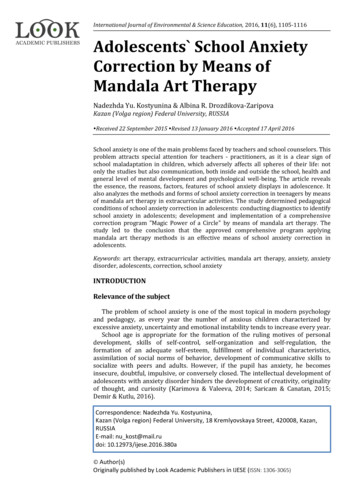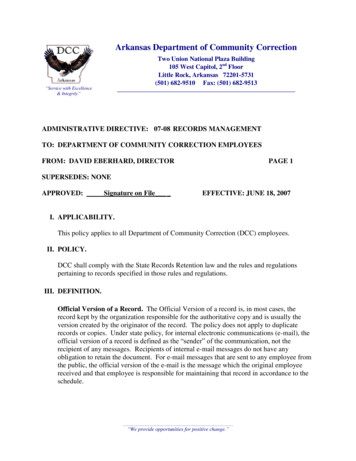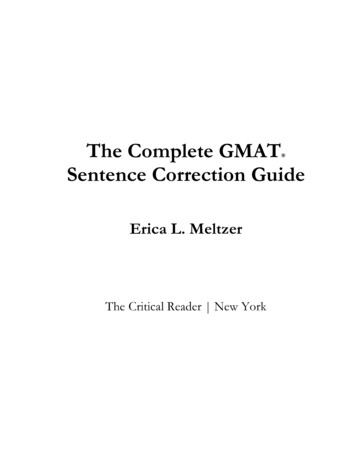
Transcription
The Complete GMATSentence Correction Guide Erica L. MeltzerThe Critical Reader New York
Copyright 2016 The Critical ReaderAll rights reserved.No part of this publication may be reproduced in any form or by any means, electronic or mechanical, including photocopy,recording, or any information storage and retrieval system, without written permission from the author. For information, pleasesend correspondence to thecriticalreader1@gmail.com.GMAT is a recognized trademark of the Graduate Management Admission Council, which is unaffiliated with and does notendorse this product.ISBN-13: 978-0-9975178-0-4ISBN-10: 0997517808
ALSO BY ERICA MELTZERThe Ultimate Guide to SAT Grammar & WorkbookThe Critical Reader: The Complete Guide to SAT ReadingThe Complete Guide to ACT EnglishThe Complete Guide to Reading EnglishGRE Vocabulary Workbook
TABLE OF CONTENTSIntroduction6 Sentence Correct Cheat Sheet8 Parts of Speech91. Building a Sentence122. Non-Essential Clauses20Exercise: Identifying Non-Essential Words and Phrases3. Sentences and FragmentsExercise: Sentences and Fragments4. Subject-Verb Agreement25273335Exercise: Subject-Verb Agreement43Cumulative Review #1: Chapters 1-4465. Verb Tense and Form48Verb Exercise #1: Present Perfect, Simple Past, Past Perfect, and PastInfinitive51Verb Exercise #2: All Tenses and Forms566. Noun and Pronoun AgreementExercise: Noun and Pronoun Agreement7. Relative PronounsExercise: Relative Pronouns8. Adjectives vs. Adverbs6067707375Exercise: Adjectives vs. Adverbs77Cumulative Review #2: Chapters 1-8799. Modification82Exercise: Dangling Modifiers84Exercise: Misplaced Modifiers87
10. Word Pairs90Exercise: Word Pairs9411. Parallel Structure96Exercise: Parallel Structure10512. Faulty Comparisons109Exercise: Faulty Comparisons115Cumulative Review #3: Chapters 1-1211713. Shorter is Better – Except When it Isn’tExercise: Wordiness12012414. Participles and Gerunds (Good –ING, Bad –ING)Exercise: Participles and Gerunds12713515. Idioms and Diction139Exercise: Idioms and Diction15116. Putting It Together154 Multiple Choice Practice Questions161 Answer Key188 Answers and Explanations: Multiple Choice Practice Questions202About the Author281v
IntroductionI know you’re probably eager to get down to business (literally), so I’ve done my best to keep this part short. There arenevertheless a handful of points I feel obligated to make here, so if you’ll humor me, I’ve outlined them below.First, the Verbal section is at the end of the GMAT . That may be an obvious fact, but if you haven’t sat for a fulllength standardized test recently, you may not be aware of the mental and psychological implications. By the time youarrive at your first Sentence Correction, you will have completed both the Essay and Quantitative portions of theexam. You will have already endured several hours of testing, and your energy and focus will, to some extent, becompromised. A portion of your brain will probably still be trying to think about whether you really should havepicked (B) on number 15 of the previous section, or whether you multiplied a number by 10 when you should havemultiplied it by 100 on number 35. Questions that might have seemed obvious two hours ago may seem confusing,and you may need an extra second or two to fully process the information in front of you.Second, you will be taking the GMAT on a screen. Again, this fact may seem so basic that it barely seems worthmentioning, but if you are doing the majority of your preparation on paper, it should not be minimized. Reading ona computer is not the same as reading on paper. Although you may have scratch paper to work out your answers on,you cannot physically draw lines through answer choices, nor can you cross out non-essential portions of sentencesto better focus your field of vision on the most relevant information. You are also more likely to overlook, insert, andmisread letters and words – and unfortunately, the distinction between the correct answer and one or more of theincorrect answers can come down to a single word, even a single letter. Add in the fatigue factor and the secondguessing that often accompanies it, and you can end up with a recipe for disaster.As a result, you must make sure to pay very close attention to which words the underlined portion of a sentence doesand does not include. Your brain has a tendency to fill in words it expects to see, a phenomenon that is oftenexaggerated when you read on a screen. As long as your proctor does not object, you may even want to physically putyour finger on the screen as you read. This might feel a bit ridiculous, but doing so can help ensure that you read whatis actually written, as opposed to what your brain thinks should be written. (If you find this technique distracting, youare of course free to disregard it; I mention it because I happen to find it useful.)To illustrate, consider the following question:Among elephants living in families in the wild, older females often have the greatest vulnerability because theirlarge tusks, which make the animals exceptionally attractive to poachers in search of ivory.(A)(B)(C)(D)(E)older females often have the greatest vulnerability becauseolder females are often the most vulnerable due toolder females often having the most vulnerability becauseolder females are often the most vulnerable and due toolder females are often the most vulnerable because ofThis isn’t an overly difficult question, but assuming you know that because rather than due to should be used (we’ll getinto why later), it does have the potential to be tricky for a reason entirely unrelated to grammar.The original version of the sentence is in fact not a sentence at all but rather a fragment. The verb make belongs to thesubject which – the subject of the clause set off by the comma – rather than to its intended subject, tusks.As a result, the second clause (because their large tusks, which make the animals exceptionally attractive to poachers in search of ivory)is missing a main verb. (A) is therefore incorrect.What people can easily think they see in the original version, however, is this: older females often have the greatest vulnerability because of their large tusks, which make the animalsexceptionally attractive to poachers in search of ivory.6
That, of course, is perfectly acceptable as a sentence. The problem is that it’s not what’s written! But because it’s what alot of people are expecting to see, their eye automatically fills in the word of. As a result, they pick (A) and get the questionwrong, even though they understand perfectly well the concept being tested.In contrast, (E), the correct answer, actually includes the word of. But if you don’t notice exactly which words areincluded in each of those versions, you’ll have no way of deciding between the answers.So to reiterate: the difference between a pretty good score and a very good score is not just a matter of what you know,but also one of how carefully you work. On the GMAT, you have no choice but to sweat the details.Lastly, Sentence Correction questions are interspersed with Reading Comprehension and Critical Reasoning questions.Sometimes, you may see a few Sentence Corrections in a row, and other times you may see a single Sentence Correctionquestion bookended by other question types. By necessity, you must be able to flip in and out of grammar mode veryquickly – the rules must be at your fingertips, so to speak. In addition, you can’t afford to let yourself get thrown by afirst Sentence Correction that appears after four Reading Comprehension questions. Because the test is adaptive, acareless mistake early on can have serious repercussions for your score. Again, an obvious point, but one that cannot beoveremphasized.The good news is that among the various types of questions that appear on the Verbal portion of the GMAT, SentenceCorrections are probably the most straightforward. Unlike Reading Comprehension and Critical Reasoning questions,which can ask you to wade through considerable amounts of information, Sentence Corrections are always limited toone sentence. As a result, they can provide a welcome respite from the kind of mental contortions required by the restof the section. If you’re properly prepared, they can be a relatively easy source of points.That said, Sentence Corrections can pack an impressive amount of information – sometimes very confusing information– into a remarkably small amount of space. If you don’t have a solid understanding of what you’re looking for, thesequestions can on occasion be nearly as mind-bending as other types of GMAT questions. Like the other two Verbalquestion types, Sentence Corrections present you with a mass of information, some of which is relevant and some ofwhich is not. In order to conserve your energy for more difficult question types, you must be able to distinguishbetween information that is relevant to answering the question, and information that is simply there to distract you. In asentence of 30 words, for example, it is possible that only 10, or even fewer, will actually be important. Conversely, youmust know when to take an entire sentence into account when only a single word is underlined. The purpose of thisbook is therefore to teach you just what you’re up against, and to give you the tools to anticipate it.At every point, I have sought to strike a balance between depth and clarity: I have attempted to discuss conceptssufficiently in-depth to allow you to understand the logic that underpins them as well as their applications to a variety ofsituations, while avoiding any potentially confusing information not directly applicable to the GMAT. Consequently, Ioccasionally simplify concepts in order to allow you to apply them more easily to the exam.One note about the exercises in this book: In my very considerable experience teaching grammar for a range ofstandardized tests, I have found that the ability to recognize correct answers is by itself insufficient. Rather, to mastermaterial to the point at which you are virtually unshakeable during the actual exam, you must be accustomed tocorrecting errors yourself. And the harder the grammar, the better off you are being able to predict corrections beforeyou even look at the answers. As a result, I have chosen not to place the exercises at the end of each chapter in multiplechoice format.To help you see how the material in this book applies to actual released GMAT questions, I have provided a list ofrelevant questions from the 2017 Official Guide for GMAT Review and the 2017 Official Guide for GMAT Verbal Review. Ihave also referenced specific questions in those guides throughout the book in order to illustrate how certain rules aretested on the exam. You should, however, be aware that there are a few concepts covered in this book that are nottested or deemphasized in the 2017 guides. When that is the case, the concepts have appeared either in earlier editionsof the Official Guides or in official GMAT practice software.Erica Meltzer7
Sentence Correction Cheat Sheet1)Don’t ignore the non-underlined portion of the sentence; it may include key information.2)Shorter Better3)Non-essential clauses are often used to distract from errors and “pad” sentences. Cross out to makesentences easier to manage.4)Alternating singular and plural verbs subject-verb agreement question. –S singular; no –S plural.5)“Subject conjugated verb” & nouns usually right; –ING usually wrong (with the exception ofparticiples used to join clauses).6)Make sure it(s) and they/their agree with their referents.7)Which often wrong answer. This word must refer back to the noun that immediately precedes it. Thereferent cannot just be implied.8)Which comma, that no comma.9)Where places, not times, books, works of art, etc.10)Whose both people and things. Who people only, which things only.11)Due to usually wrong.12)Use such as, not like, to introduce examples. Note that the construction such noun as is correct.13)A participial phrase (e.g. having gone, written in) at the start of a sentence usually dangling modifier.14)Make sure modifiers (adjectives, adverbs, prepositional phrases) are placed next to the words they areintended to modify.15)Know top word pairs: not but, both and, between and, so/such that, from to, (n)either (n)or, just as so.16)Amount, much, less singular nouns; number, many, fewer plural nouns.8
15. IDIOMS AND DICTIONI. TransitionsThe GMAT is not overly concerned with testing your ability to identify logical relationships between statements, butquestions do occasionally target this concept from an idiomatic standpoint.Although correct and incorrect answers to transition questions may not directly hinge on the (mis)use of a particularconjunction – that is, there may be additional, unrelated factors that make the correct answer right and the incorrectanswers wrong – certain transitions are nonetheless likely to appear only in correct answers, whereas others are likely toappear only in incorrect answers.Cause-and-Effect: Because, Due To, WhenIn sentences involving causes and effects, you are likely to be asked to decide between because and due to. Note that it isunlikely (although not impossible) that you will encounter due to used correctly on the GMAT. Because the misuse ofthis expression is so rampant, the GMAT is primarily concerned with your ability to recognize when it isincorrect.That said, the phrase due to can correctly be used before a noun, as a synonym for caused by. If you are not sure whetherdue to is appropriate, plug in caused by and check whether that phrase makes sense.Incorrect:Most Tudor uprisings failed due to (caused by) the weakness of the rebels as well asthe power of the reigning monarchs.Correct:The failures of most Tudor uprisings were due to (caused by) the weakness of therebels as well as the power of the reigning monarchs.In addition, phrases including due to tend to
Sentence Correct Cheat Sheet 8 Parts of Speech 9 1. Building a Sentence 12 2. Non-Essential Clauses 20 Exercise: Identifying Non-Essential Words and Phrases 25 3. Sentences and Fragments 27 Exercise: Sentences and Fragments 33 4. Subject-Verb Agreement 35 Exercise: Subject-Verb Agreement 43 Cumulative Review #1: Chapters 1-4 46 5. Verb Tense and Form 48 Verb Exercise #1: File Size: 2MBPage Count: 35
